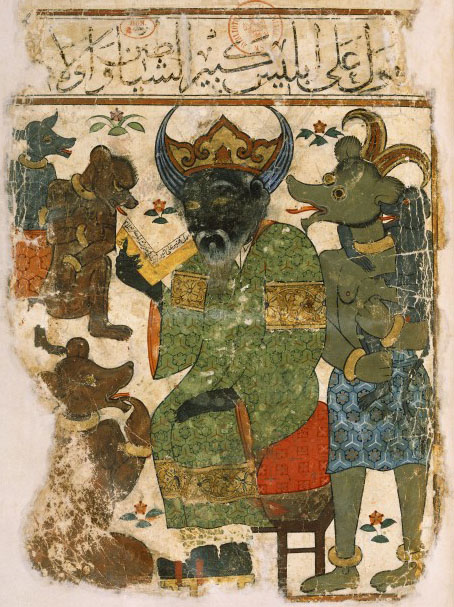
The Djinn, called “God’s other people”, and the name meaning “hidden or concealed” are spirits from Islamic mythology. They are beings that live outside of our dimensional plane, yet interact with humans in various ways. This land is often referred to as Kaf (Mount Qaf or Qaf-Kuh) which in Islamic mythology is a legendary mountain made of shining emerald, the home of the Djinn.
However, we can look further back to the ancient Persians who believed in a similar spirit called jainni and jaini, being of the masculine and feminine. Inscriptions dating back three thousand years, show that djinn-like beings, called ginnaye meaning the “rewarding gods” and “gods of pleasure and pain”, were worshipped. In the legends these gods were largely benevolent, but could suddenly turn without warning. It could be said that they are the same as the Fae of European Tradition, the ‘inorganic beings’ that don Juan mentioned to Carlos Castaneda, and various other Otherwordly Beings that we find in tales and mythology throughout human history.
It is mentioned in the Qur’an that the Djinn were created by Allah before humans. Nobody is certain of when they were created, but tales suggest it was around 2,000 years before the first human. They built civilizations and some suggest that they burnt it all down, much like humans are now doing to our planet. Could this have been a race of beings that walked the earth, stripped all of its resources and were then banished to a parallel existence in order to replenish the earth’s resources? Could it be that humans were the next experiment, to see if beings created from clay and dirt could be better than those created from the “smokeless fire” of the desert? Who knows, but its interesting to consider.
Indeed, We created man from sounding clay moulded from black mud. As for the jinn, We created them earlier from smokeless fire.
Qur’an Al-Hijr 15.26-27
The Fall of Iblis
There are varying stories regarding the origins of Iblis. One account mentions him to be a high-ranking angel named Azazel who was instructed to obliterate the Djinn from earth so that they could be replaced by humans. Another account states that he created from the fires beneath the seventh earth and after thousands of worship to Allah, he was raised to the company of the angels in the seventh heaven.
Whichever account is correct, Iblis was the leader of the Djinn, created from something different form the angels, that being a spiritual light, but loved by Allah and allowed to stand with Allah. However, when the first human was created, Allah instructed all of the angels to prostrate before this new creation. Iblis refused and was cast out of Paradise. Iblis was therefore sent to earth to lead the Djinn and to stray until the Day of Judgement.
And [mention, O Muhammad], when your Lord said to the angels, “I will create a human being out of clay from an altered black mud. And when I have proportioned him and breathed into him of My [created] soul, then fall down to him in prostration.”
So the angels prostrated – all of them entirely, Except Iblees, he refused to be with those who prostrated.
[ Allah ] said, O Iblees, what is [the matter] with you that you are not with those who prostrate?”
He said, “Never would I prostrate to a human whom You created out of clay from an altered black mud.”
[ Allah ] said, “Then get out of it, for indeed, you are expelled. And indeed, upon you is the curse until the Day of Recompense.”
He said,”My Lord, then reprieve me until the Day they are resurrected.”
[ Allah ] said, “So indeed, you are of those reprieved
Qur’an Al-Hijr 15.28-37
In regards to Iblis being Azazel, it is worth going into the mythology of the Grigori or The Watchers. Azazel is often also called Shemyaza (in some stories they are not the same Angel, but stood alongside each other in the rebellion), the leader of the Grigori who led the rebellion of the Angels to teach humans various skills and to mate with human women, because he and the other Watchers were enamored with earth and humans. It is mentioned in the Qu’ran that Iblis said he would prove that humans are not worthy of God’s love, and would lead them astray. I would say that this tale and that of the Grigori are one in the same, and that Iblis/Azazel/Shemyaza are the same Angel. I personally work with Azazel and Shemyaza as two aspects of the same entity.
The Orders
Of all of the Orders and Classes of the Djinn that I have come across, the best and most extensive comes from the book The Vengeful Djinn: Unveiling the Hidden Agenda of Genies by Philip J. Imbrogno and Rosemary Ellen Guiley. From the Appendix of the book, we find the following:
Black Djinn
The most powerful of all djinn, little is known about them. The only reference we have is from ancient Persia, where they were called shamir.
Blue Djinn
The elders and clan leaders of the djinn order. They have little interaction with humans, but have been known to participate in important moments of history. They are known as Marid, Nekratael, and Afreet.
Yellow Djinn
Middle-aged djinn with considerable power. Most are family leaders. They have little if no interest in the human race and the physical world. They are known as Juzam and the nastier ones are called Efreeti.
Green Djinn
Youngest and least powerful of the djinn. They are curious and like to interact with the human race in the physical world. Many young ones like to play pranks on humans. They are known as Erhnam, Kookus, Aamar, Arwaah, Jann, and Amir.
Red Djinn
Very old and powerful djinn. Most were once blue djinn. They worship Iblis and their goal is to destroy all humans. They are served by other djinn, and in rare cases, humans. Some serve willingly, some by force. They are known as ghouls, shaitan or shayteen, and ifrit.
The Ifrit are said to be the Djinn that King Solomon bound and tortured.
The Solomonic Problem
When it comes to King Solomon and the Djinn, we will have to talk about one of the books from The Lesser Keys of Solomon, the Ars Goetia. Although the 72 spirits in this grimoire are said to be “demons” or “devils” they are Djinn. Now there are several problems with this book, of which two I would like to discuss.
Firstly, the names of the 72 Spirits of the Goetia are not the original names of the Spirits that Solomon summoned. The original text which was Miscelaneo de Solomon which was translated and put into book format by Nineveh Shadrach, titled The Book of Dead Names, lists 72 Spirits with very different names and callings. It is suspected that it was much later that the text of the Goetia was formulated as a combination of Miscelaneo de Solomon and The Book of the Offices of Spirits (Liber Officiorum Spirituum), the names changed and the inclusion of ritual formats that were not in the original , plus the exclusion of herbal lore which was in the original text. Johann Weyer’s Pseudomonarchia Daemonum used Liber Officiorum Spirituum as a source, and Pseudomonarchia Daemonum is also said to be one of the source books for the compilation of the Ars Goetia.
So, who are the Spirits within the Goetia? To the best of my knowledge, they are Djinn, however they are not the Djinn that King Solomon used (and abused). At least, not the Ifreet of the original working that were forced to built the Temple of Jerusalem. However, they are quite real and tales do refer to the spirits from the Ars Goetia as being those that King Solomon coerced into slavery. This is where the second problem comes up.
I can’t say that King Solomon was and is the only turd to have done this, but he is the best recorded, however he treated these Spirits so disgustingly, that they became quite annoyed with humans to the point where they can’t trust humans and wish us all dead. Quite frankly I can’t blame them. It is for this reason that if you wish to work with them, approach very slowly. The 72 Spirits that we find in the Goetia as we know it today have become quite amenable to us humans as they have found some respect again, but be wary anyway. If they decide they don’t like you, don’t push it.
King Solomon quite literally enslaved, beat and tortured these spirits. It started off with Ornias who was told to cut stones for the Temple using iron tools, which is quite harmful to these spirits. In order to end his suffering, Ornias made a deal with Solomon and forced Beelzebub to come to Solomon by throwing Solomon’s ring at him. Beelzebub was forced to cut blocks of Theban marble, and because Beelzebub is a mighty prince and rules over Tartarus, the humiliation made the other Djinn howled in protest. Being helpless, Beelzebub agreed to call the Djinn for Solomon who then discovered how to nullify them by the power of the angels.
As the tale goes, one of them at least, the first was a female Djinni named Onoskelis who was sentenced to spinning hemp ropes. The second was Asmodeus, who was extremely pissed and threatened Solomon with a prediction of how the Djinn will one day be free and reign over humans like Gods. Solomon decided that his punishment would makes things a-okay (moron) and sentenced Asmodeus to be weakened by iron, carry ten water jugs and to make clay by treading it.
Of course it didn’t stop there and later Solomon imprisoned an unknown number of Djinn is brass bottles laced with iron as well as holding them captive in magic rings.
This of course is my biggest gripe with Ceremonial Magicians who think it is ok to bind, trap and threaten the Spirits of the Goetia, and it is why we hear the stories of the Spirits fighting back every now and then. Serves them right.
In Conclusion
The Djinn are a fascinating subject, however because they have such a disdain for humans, firstly because they refused to bow to humans (not sure why they had to do that in first place), and secondly because they have been so badly treated over centuries, it is a good idea to approach them with extreme care. As mentioned the 72 Spirits of the Ars Goetia are more inclined to work with humans, and if we treat them the proper respect they deserve, they can be very friendly.
There are many stories and tales that are absolutely astounding, and even mention of Djinn marrying humans. We also have S. Ben Qayin’s book about the Ifreet that Solomon so liberally pissed off, The Book of Smokeless Fire. Although an interesting book in relation to the history of the Djinn and the applications of magick, I wouldn’t suggest going down the road of summoning these particular spirits. As Qayin himself mentions, “They are hate, pain and disease waiting to be released upon the world with a rage that is unmatched.”
References:
The Vengeful Djinn: Unveiling the Hidden Agenda of Genies by Philip J. Imbrogno and Rosemary Ellen Guiley
The Book of Smokeless Fire by S Ben Qayin
1001 Nights by Richard Francis Burton
The Qur’an
